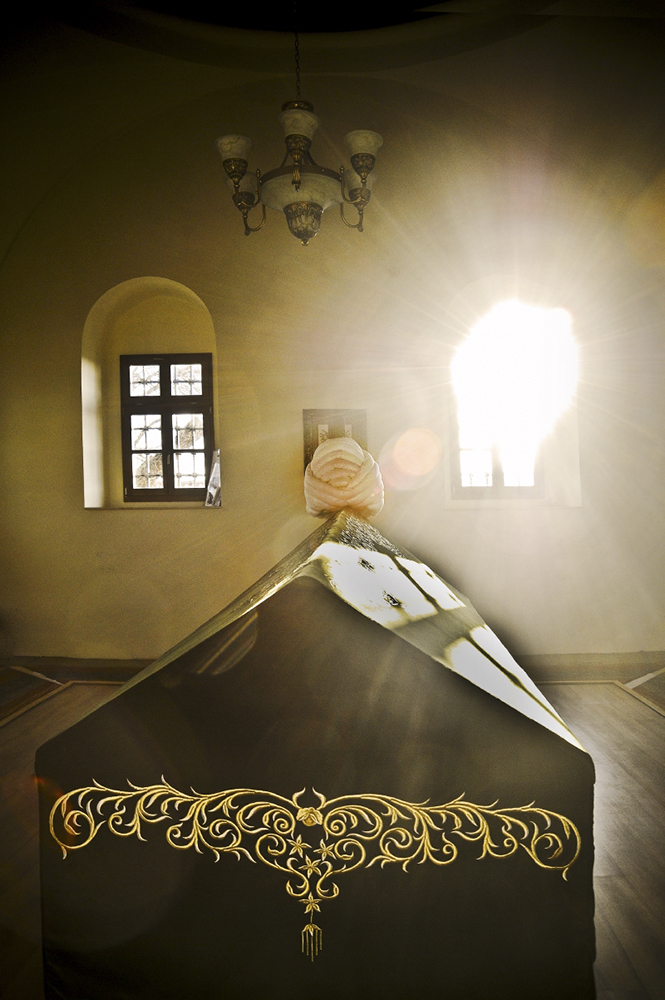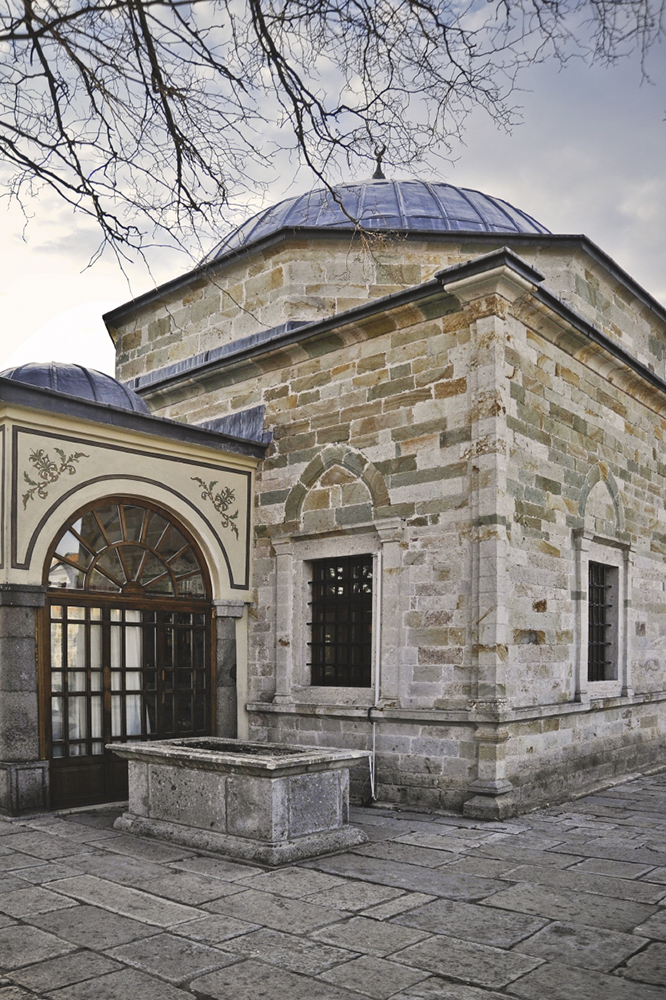The following is an excerpt from “Minarets in the Mountains: A Journey into Muslim Europe” by Tharik Hussain, published in July 2021 by Bradt Guides. Throughout the book, Hussain and his family travel the Balkans, following in the footsteps of 17th century Ottoman chronicler Evliya Celebi.
When Evliya visited the tomb of Murad I, he was unimpressed, to say the least. The Ottoman traveller describes how he and his high ranking patron literally have to wade through shit, and when Melek Pasha’s elegant robe is stained by human faeces, it is the last straw. The pasha reportedly flies into a rage, disgusted at the state of the tomb of one of their greatest sultans. Meanwhile, his nephew Evliya points out that Murad’s murderer’s tomb, on the other hand, is ‘lit with jewelled lamps and scented with ambergris and musk’ and tended to by priests who welcome visitors. The reason the ‘infidels’ come and shit in here, explains Evliya, is because there is no-one to stop them.
Hearing this, the pasha demands the tomb be cleaned up and hires locals to do so immediately. The shit is shovelled out, a well is dug, five hundred fruit trees are planted and ‘a high wall with a lofty gate’ is built around the mausoleum so that even ‘people on horseback could not get in’. The türbe is furnished inside with silk carpets and ornate lamps, candles are lit and rose water is sprinkled. Melek Pasha then employs a family to live there as caretakers, building them a home and paying them an annual salary. The tomb is finally fit for a king.
Evliya and his pasha might well have left yesterday, such was the pristine condition of Murad’s tomb when we arrived there from Novi Pazar. A black iron gate opened up to a courtyard surrounded by the pasha’s stone wall. Despite two busy highways thundering past on their way to Pristina, there was an air of calm and serenity inside the mausoleum’s grounds. A black and white dog sat with his tongue hanging out in the shade of young fruit trees on an immaculately tended lawn.
Grey paving stones led up to a white villa that would not have looked out of place beneath a Tuscan sun. A gold plaque said this was the ‘Selamlik Building’ or ‘Cultural and Promotion House’, built in 1896 and restored by TIKA, the Turkish Co-operation and Co-ordination Agency. The house was built as a visitors’ building shortly after the site was refurbished by Sultan Abdulmejid I. After that the tomb was apparently restored one more time by the Ottomans before it fell into the custody of the Yugoslav authorities who also carried out a restoration.
Murad’s tomb was once again in a condition befitting a king - one who might well be the grandfather of Muslim Europe.
A second gate led into the historic perimeter of Murad’s mausoleum. Everything felt pristine and freshly scrubbed here. TIKA had firmly taken the baton from Evliya and Melek Pasha; Murad’s tomb was once again in a condition befitting a king – one who might well be the grandfather of Muslim Europe.
When Murad I, the third sultan of the then-new Turkic Empire, fell at the spot we now stood on in 1389, he had taken his fledgling regional power into a new continent, grabbed coveted Byzantine territories, and turned the Ottomans into an international tour de force. Murad’s expansionism put the new empire on course, over the next two centuries, to become the greatest Muslim dynasty the world had ever seen.
Murad died here during the Battle of Kosovo. Their foes on the day were led by Serbian Prince Lazar, King Tvrtko of Bosnia, Vuk Branković (Lazar’s son-in-law), Wallachian Prince Mircea the Great and a number of Albanian princes. Those aligned with the Ottomans included Constantine, Bulgarian Prince Kostendil, several Serbian princes that were rivals to Lazar, and a number of Anatolian Turkoman princes.
Evliya rather outlandishly claims Murad put 700,000 infidels to the sword, but historians believe there were around a fifth of that many soldiers at the battle in total. During the clash, the European allies initially had the upper hand, and it was only when Branković defected that the tide turned in favour of the Muslim-led army. It is unclear whether Murad died before or after victory was declared, but upon his death it was his son Bayezid who became the next Ottoman sultan and is said to have built the original mausoleum here on the plain for his martyred father.

The interior of Sultan Murad’s tomb. Photo: Atdhe Mulla / K2.0.
How Murad died is a source of contention, with a host of myths and legends emerging shortly after. Evliya offers us one of the more evocative versions: victory had already been declared and, as Murad wandered on the battlefield, ‘an inauspicious infidel named Koblaki’ rose up from amongst the dead opposition soldiers and killed Murad before trying to flee on horseback. Ottoman soldiers chased after him but couldn’t knock him off, until an old woman said they should strike the horse’s hooves. When an archer did this, Koblaki was surrounded and had his throat slit.
Evliya says that the sultan’s kidneys, liver and heart were then removed to prepare his body for transportation to Bursa, and buried on the spot where the türbe now stands. This was the very first Ottoman structure in Kosovo, and became a site of pilgrimage.
Murad, then, was the reason Islam made its way into Europe a second time. Ironically, this was happening just as the community from the first arrival was being squeezed out of Europe. Muslims had turned up in Spain as early as ad 711 to found a flourishing society based on interfaith existence, one that accommodated Christians and Jews – something the Ottomans would also emulate. But, within the next century, the Spanish Muslim presence would come to an end when the last Muslim city of Granada in southern Spain was taken by the Catholic Monarchs Isabella I of Castile and Ferdinand II of Aragon in 1492. Many of the expelled Spanish (Sephardic) Jews would make their way into Ottoman territories. This meant Murad’s victory ensured the continued presence of Muslims and Sephardic Jews in Europe; one that remains to this day.
We entered the second set of gates to find Evliya’s ‘radiant shrine of the martyr sultan, Ghazi Khudavendigar’ (devotee of God) almost exactly as he had described it: surrounded by several important graves in a well-maintained garden where roses were in bloom. The most impressive of these had tall, slim tombstones with delicate Persian inscriptions and bases inspired by Greco-Roman designs.
I wondered whether the ancient tree was one of those planted by Evliya and Melek; it certainly looked old enough.
Two women in long skirts and sleeveless tops walked in ahead of us and were greeted by an elderly woman in a patterned headscarf. She had been sat in a chair in front of a small house to the right of the inner court, the legacy of the caretakers Melek Pasha had installed to look after the tomb. The woman’s family were descendants of a Haci Ali from Buhara, who was given the job in the middle of the 19th century.

Sultan Murad’s tomb. Photo: Atdhe Mulla / K2.0.
I watched as the two women pushed some notes into the hand of Haci Ali’s descendant. She took the money and urged them to go left towards the entrance of the türbe, giving them instructions in a language we didn’t understand. I took out some notes from my wallet and did the same. The woman, realising we did not speak Albanian, led us round to the door of the tomb, next to which stood an ancient tree bent over with age. The tree was clearly important, as it was now being supported by two thick metal poles. I wondered if it was one of those planted by Evliya and Melek; it certainly looked old enough.
My daughter Amani was eyeing it with intent and saw me shaking my head. Climbing trees has always been one of her greatest joys. We are lucky enough to live near Epping Forest on the outskirts of London and, as children, both girls had their favourite trees there. Often, they would disappear up one, armed with a book, so that for the next half hour or so, only a tiny face partially covered by a Jacqueline Wilson title was visible through the branches and leaves.
My other daughter Anaiya was also eyeing up something – the tomb’s resident cat. She was crouched down, stroking the thin black cat using a fallen leaf, just as we had agreed – no touching. Neither of them was keen to enter the tomb, so leaving them where we could still see them, my wife Tamara and I headed inside the türbe.
Tamara looked up and was genuinely shocked. ‘I’m not sure about this,’ she whispered as she walked out.
Murad was also married to a Tamara; Kera Tamara, the daughter of medieval Bulgarian Emperor Ivan Alexander. Murad asked for her hand in marriage to guarantee peace between the two empires. It was common practice in those days for rulers to marry women from other ruling families and strengthen their ties, but the story of Tamara is interesting for two reasons: firstly, because Tamara did not convert to Islam and was allowed to remain a practising Christian; and secondly, because her marriage is remembered in Bulgarian folklore as a sacrifice she made for her people. Tamara’s tomb is also in Bursa, next to her husband’s second tomb.
Tamara and I entered a small porch through a set of glass doors. Inside, it felt like a little greenhouse; a number of large beautiful plants sweated in the warmth created by the brilliant sunshine streaming through the glass. This included thick ivy climbing around the elaborately decorated entrance to the main chamber. Hanging from one corner of the porch was the red flag of Turkey and beneath this were scarves for women to place on their heads. As Tamara put one over her head, I could see a woman circumnavigating Murad’s large purple tomb, the way Muslims do around the Kaaba. I nudged Tamara, who looked up and was genuinely shocked. We both were; neither of us had ever seen anything like this at any of the Muslim sites we had visited before. It clearly made Tamara even more uncomfortable than me because soon after this she decided to leave.

Minarets in the Mountains: A Journey into Muslim Europe by Tharik Hussain. Photo: Courtesy of Bradt Guides.
‘I’m not sure about this,’ she whispered as she walked out.
Amani would later tell me it was the look on her mother’s face that prompted her to come in. She entered just as the woman was finishing her circumnavigation of Murad’s wooden sarcophagus.
The woman then sat down at the head of the tomb beneath the large white turban. Her head was wrapped in one of the borrowed scarves, but her arms remained exposed in a sleeveless vest. As she sat reciting under her breath, the elderly caretaker returned with a cardigan and some books for her to recite from.
I had grown up seeing all kinds of acts of reverence being performed at the shrine of Shah Jalal in Bangladesh.
Amani and I walked around the room. Above us the türbe’s dome had the most beautifully painted rose from which hung a chandelier; it was surrounded by Arabic inscriptions and a red and gold floral pattern. Light streamed in from windows on all four walls and I noticed the elaborate latter-day insignia of the Ottoman Empire hanging on one of them.
‘So that’s why mum was a bit freaked out,’ Amani whispered as we stepped back into the bright sunlight.
‘Yes, it certainly wasn’t the kind of ritual I had expected to see in a tomb for a sultan.’
‘Shrines freak me out a little,’ said Tamara as we headed back to the car.
Tamara’s introduction to Islam had led to my reintroduction to the religion. This was via the conservative brand of Islam known as Salafism, which became popular in Saudi Arabia from around the 19th century and preaches a literal, uncompromising ‘return’ to a puritanical and ‘pristine’ Islam. Its advocates believe this version of Islam is the way the religion was practised by the Prophet and the first generation of Muslims in the 7th century, and therefore the correct and only way to practise Islam. Salafism sees saints, grave reverence and shrines as heretical, which is probably why such spaces made Tamara uncomfortable.
I, on the other hand, had grown up seeing all kinds of acts of reverence being performed at the shrine of Shah Jalal in Bangladesh. In fact, the stories of Murad and Shah Jalal had several parallels. Both were of Turkic origin and been credited with bringing Islam to a region where many local Muslims remain grateful for this. Both had achieved this by taking part in an epic battle – Shah Jalal’s was with the local Hindu king, Gour Gobind. Although one had arrived as a missionary and the other as a sultan, over time both men had become saints to many. It was for this reason some people came to Murad’s tomb, like they did to Shah Jalal’s in Sylhet, with very different ideas about how to pay their respects to the sultan-cum-saint.
Bradt Guides is offering readers of Kosovo 2.0 a 25% discount off “Minarets in the Mountains.” To claim your discount, visit bradtguides.com/shop and enter code KOSOVO2.0 at checkout. Offer valid until December 31, 2021.
Feature image: Atdhe Mulla / K2.0




